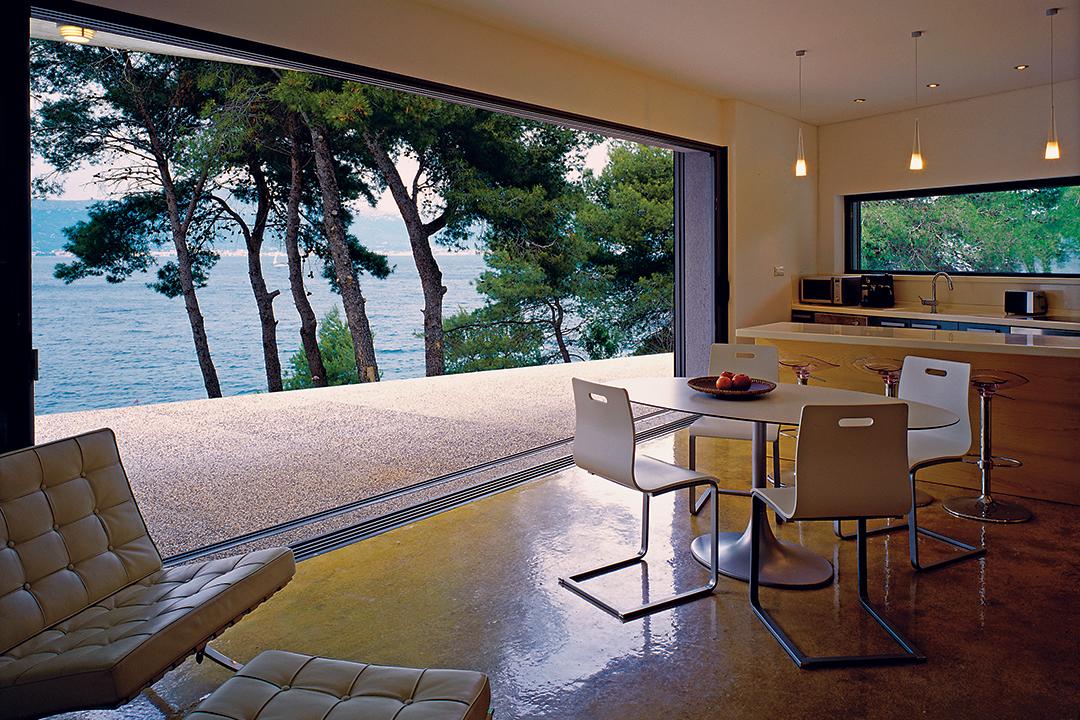When people talk of holiday houses, it is something that refers to a relatively small segment of people in the world who are able to afford such a building and also have the necessary spatial resources and natural conditions at their disposal.
The fact that there still exists today a desire for a permanent place, a summer residence, despite the ever more available opportunities for world travel, represents, to the casual eye, a dichotomy of contemporary man who propagates an extreme mobility and freedom of choice as a situation of ultimate contemporary democratic society.
It is precisely natural conditions, nature, that produce people’s need to escape from a safe urban dwelling into a temporary refuge, usually located in a small place or just a solitary house. The feeling of distance from the urban and connection with nature is far more pronounced still if the location is an island surrounded by an expanse of open sea.
In Croatia, the largest number of summer residences, summer houses, well conceived in terms of architecture and well set in space is located in the area which used to belong to the Republic of Dubrovnik. These buildings, with their gardens and grounds, were not only intended for the retreat of townspeople from the summer heat of Dubrovnik, but were also significant social and, certainly, economic centres. Their setting in space was always carefully chosen and with this, a recognizable identity of high-quality spatial management of the Republic of Dubrovnik was realized.
Le Corbusier’s prefabricated ascetic wooden cabin on Cap Martin from 1952, his own holiday house, is a nice example of how spending summer holidays in touch with nature is important for modern man as well. The wooden cabin was built in the vicinity of the summer residence of Eileen Grey, who was host to Le Corbusier on a number of occasions in her white modernist villa built in 1927 and equipped with all the comforts available at the time of its construction. Even today, the subject of holiday houses is still topical, among clients as well as among architects, and this can be seen in the example of the extraordinary realization of a holiday house built on Cap Ferret in 1998, the work of architects Lacaton Vassal.
The concept of a minimal house for holidays at the seaside, where people really want to live in touch with nature is also realized in the case of the summer residence of the Dompnier family on the island of Čiovo by architect Darinka Kuzmanić. The fact that one member of this family has roots in Dalmatia, and perhaps the similarity of the natural ambience which is excellently preserved in Croatia, in comparison with the Côte d’Azur, were factors that produced the desire for a holiday house on Čiovo.

The architectural concept of the house is based on an important analysis of how to place a building volume on an extremely sensitive location, one of the last within the scarcely populated forest environment of the village of Slatine. The building volume is set on a steep plot with a northern orientation so that it does not obstruct the view when we approach the site by the local road. It is, namely, placed further down on the slope, below the level of the road. When we approach the site entrance, we can see a pergola above the parking place and the roof surface of the building volume, showered with white pebbles from the beach. Such a setting of the house volume, that does not obstruct vistas, is not significant just for its owners, but also for all others who, in order to reach the beach, use the public path by the house which leads to the sea. Here, another peculiarity of the house is disclosed. The ground plan of the house is triangular which was dictated by the shape of the site, as well as by the building line stipulated by the urbanistic plan. In spite of the ground plan’s unusual shape, the concept of the house is solved without flaws and even uses some advantages of the triangular shape: views are open towards the sea of Kaštela Bay, and in the background towards the mountain massifs of Kozjak and Mosor.
The day and night rooms’ arrangement is logically realized through the cross section using, to the greatest degree, links to exterior terraces, that epitomize the essence of summer living in touch with nature. The connection is consistently realized by means of sliding glass walls and this also creates an impression of larger interior spaces. Clear movement through the house brings about a feeling of the whole house being well laid out, and this is also supported by use of interior elements and materials like, for example, the longitudinal wooden partition wall between the airy staircase corridor and other secondary rooms. The entirety of the house with its interwoven nature and connection of the interior and exterior spaces offers the users a living ambience of high quality.
We can conclude with good reason that the example of the Dompnier holiday house – characterized by significantly smaller dimensions than the average for recently built holiday houses, its discrete setting in space, as well as materialization – represents a good example of construction in a sensitive location. This example could serve as model for contemporary building not only in the surroundings of the limited coastal zone but also elsewhere, in any place where architecture is linked to the natural landscape.